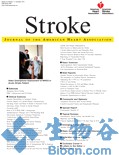Stroke:超高龄患者的运动和认知能力影响对血压与卒中之间的相关性
2013-05-06 geniusgodyu 互联网
流行病学研究中得出的超高龄患者中高血压与卒中的关系结果不一。荷兰Leiden大学医学中心老年医学与老年学系的Behnam Sabayan博士等人通过研究发现:对于超高龄患者,运动和认知能力对血压与卒中之间的相关性存在影响。相关论文发表在Stroke杂志2012年11月6日在线版上。 研究人员从人群为基础的Leiden85岁以上人群研究中纳入513为85岁的患者。基线测定收缩压、舒张压、平均动脉压
流行病学研究中得出的超高龄患者中高血压与卒中的关系结果不一。荷兰Leiden大学医学中心老年医学与老年学系的Behnam Sabayan博士等人通过研究发现:对于超高龄患者,运动和认知能力对血压与卒中之间的相关性存在影响。相关论文发表在Stroke杂志2012年11月6日在线版上。
研究人员从人群为基础的Leiden85岁以上人群研究中纳入513为85岁的患者。基线测定收缩压、舒张压、平均动脉压和脉压差。分别评估日常生活活动力和Mini精神状态测试以估计体能和认知功能的水平。使用Cox回归分析估计5年卒中风险。
结果发现:在整个队列中,除了脉压差和卒中存在可能相关(风险比[HR],0.80 [95% 可信区间 [CI], 0.66–0.98])外,其他血压变量与卒中风险都没有相关。在那些运动功能下降的患者中,收缩压较高(HR, 0.74 [95% CI, 0.59–0.92])、平均动脉压较高(HR: 0.68 [95% CI, 0.47–0.97])和脉压差较高(HR, 0.71 [95% CI, 0.55–0.93])与卒中风险降低相关。同样,在认知功能障碍的患者中,收缩压较高与卒中风险较低相关(HR, 0.80 [95% CI, 0.65–0.98])。在没有认知功能障碍的患者舒张压较高(HR: 1.98 [95% CI, 1.21–3.22])和平均动脉压较高(HR, 1.70 [95% CI, 1.08–2.68])与卒中风险较高相关。
研究人员得出结论:对于超高龄患者,运动和认知功能障碍对血压和卒中之间的相关性存在影响

doi: 10.1161/STROKEAHA.112.663062
PMC:
PMID:
High Blood Pressure, Physical and Cognitive Function, and Risk of Stroke in the Oldest Old
Behnam Sabayan, MD, MSc, Peter van Vliet, MD, PhD, Wouter de Ruijter, MD, PhD, Jacobijn Gussekloo, MD, PhD, Anton J.M. de Craen, PhD and Rudi G.J. Westendorp, MD, PhD
Background—Epidemiological studies have shown mixed findings on the association between hypertension and stroke in the oldest old. Heterogeneity of the populations under study may underlie variation in outcomes. We examined whether the level of physical and cognitive function moderates the association between blood pressure and stroke. Methods—We included 513 subjects aged 85 years old from the population-based Leiden 85-plus Study. Systolic blood pressure, diastolic blood pressure, mean arterial pressure, and pulse pressure were measured at baseline. Activities of daily living and Mini-Mental State Examination were assessed to estimate level of physical and cognitive function, respectively. Five-year risk of stroke was estimated with Cox regression analysis. Results—In the entire cohort, there were no associations between various measures of blood pressure and risk of stroke except for the inverse relation between pulse pressure and stroke risk (hazard ratio [HR], 0.80 [95% confidence interval [CI], 0.66–0.98]). Among subjects with impaired physical functioning, higher systolic blood pressure (HR, 0.74 [95% CI, 0.59–0.92]), mean arterial pressure (HR: 0.68 [95% CI, 0.47–0.97]), and pulse pressure (HR, 0.71 [95% CI, 0.55–0.93]) were associated with reduced risk of stroke. Likewise, among subjects with impaired cognitive functioning, higher systolic blood pressure was associated with reduced risk of stroke (HR, 0.80 [95% CI, 0.65–0.98]). In subjects with unimpaired cognitive functioning, higher diastolic blood pressure (HR: 1.98 [95% CI, 1.21–3.22]) and mean arterial pressure (HR, 1.70 [95% CI, 1.08–2.68]) were associated with higher risk of stroke. Conclusions—Our findings suggest that impaired physical and cognitive function moderates the association between blood pressure and stroke.
本网站所有内容来源注明为“梅斯医学”或“MedSci原创”的文字、图片和音视频资料,版权均属于梅斯医学所有。非经授权,任何媒体、网站或个人不得转载,授权转载时须注明来源为“梅斯医学”。其它来源的文章系转载文章,或“梅斯号”自媒体发布的文章,仅系出于传递更多信息之目的,本站仅负责审核内容合规,其内容不代表本站立场,本站不负责内容的准确性和版权。如果存在侵权、或不希望被转载的媒体或个人可与我们联系,我们将立即进行删除处理。
在此留言









#高龄患者#
70
#相关性#
67
#高龄#
68